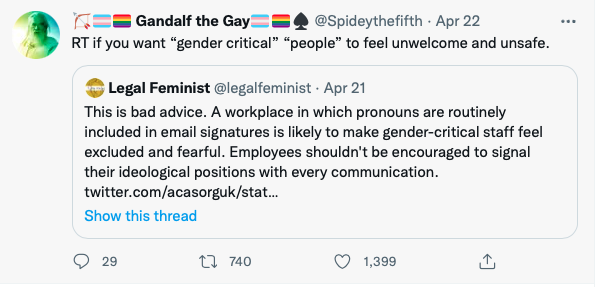This is the text of a talk I gave on Wednesday evening to employment law solicitors at my Chambers.
I should start by acknowledging the elephant in the room. I broadly share the belief that lost Maya Forstater her work with CGD: namely that biological sex is real, important, immutable and not to be conflated with gender identity. We’re not going to be discussing the substance of that belief except tangentially, but inevitably there are various respects in which the position I take will affect the way I talk about my understanding of the law.
As ever: views my own.
Staying with the elephant theme, the question I want to address is: “what are the main elephant traps for your clients in this area, and how do they avoid them?” I’m going to address that partly by reference to five cases that have been fought to a conclusion in the ET or on appeal over the last couple of years. So first, a quick outline of those cases.
The five cases
An employment tribunal held in December 2019 that Ms Forstater’s gender critical belief was not protected under s.10 of the EqA because it was “not worthy of respect in a democratic society” (or “WORIADS” as it’s come to be known). In June 2021, the EAT allowed Ms Forstater’s appeal, so that the case could be heard on its merits. In July this year, the ET held that CGD’s decision not to renew her contract had been because of her protected belief, and was therefore unlawful direct discrimination.
In Mackereth, the EAT upheld a tribunal’s decision that the DWP’s treatment of a medical assessor who refused to use the preferred pronouns of service users was not discriminatory.
In Bailey v Stonewall Equality Ltd & ors, the barrister Allison Bailey sued her chambers and Stonewall for belief discrimination. She won part of her claim against her chambers and lost other parts. She lost the claim against Stonewall, and is appealing that part of the tribunal’s judgment.
The other two cases are V v Sheffield Teaching Hospital (which Anya Palmer has written about in more detail here) and Taylor v Jaguar Land Rover. In V, a tribunal upheld the claimant’s complaint that questioning him about his habits in relation to wearing underwear at work was discrimination on grounds of gender reassignment. He had been seen naked from the waist down in a women’s changing room. In Taylor, a tribunal found a number of complaints of harassment and direct discrimination proved by a trans-identifying male employee.
Between them, these five cases shed quite a bit of light on the elephant traps I want to talk about.
The elephant traps
The “social media policy” fallacy – treating some beliefs as more equal than others
All beliefs that pass the 5 Grainger tests needed to qualify for protection are of equal status. Employers are entitled to ask their employees not to proselytise at work; and they will often be entitled to place some restrictions on their employees’ public statements outside the workplace. Exactly how far those restrictions can go will depend on a range of factors – the ease with which the employee can be identified as such, her seniority; the nature of her role, and so on. Judges and civil servants can be required to keep pretty silent, in public, on matters of political controversy; supermarket checkout staff not so much.
There has been quite a lot of comment on Forstater to the effect that CGD’s difficulties could have avoided if only they had had a robust social media policy in place.
There are two problems with that. The first is that Forsater’s engagement, though direct, was pretty measured. That means that any social media policy sufficiently restrictive to silence her on the subject of GRA reform would have had to be draconian across the board. If it had singled out “gender critical” engagement for prohibition, that would have been discrimination just the same. You can’t make discrimination disappear by making it your policy to discriminate, and then saying you acted as you did not on the prohibited ground but in obedience to your policy. An employer could in theory decide on the draconian route, and just purport to put all political or contentious social media engagement out of bounds. But trying to enforce such a draconian policy would be likely to have a high cost in both management time and industrial relations. And an employer that dismissed for breach of such a rule might well find it hard to defend as consistent with the employee’s article 10 right to freedom of expression, which will be part of “all the circumstances” a tribunal has to consider when ruling on the fairness of a dismissal.
On the other hand, if an employer writes a draconian policy but only enforces it reactively when staff members or third parties take strong exception to the expression of particular views – well, the problem with that should be obvious. Effectively you’d be letting the mob decide which opinions may be expressed. If the mob discriminates, you discriminate.
A related elephant trap may be concealed in a more limited neutral-looking policy. Suppose your policy says something like this:
You must not make any social media communication that could damage our business interests.
It looks even-handed and fairly light-touch. But if what this formula really means is that employees mustn’t express unfashionable views because third parties might object, that won’t preserve the employer from a finding of discrimination. A more familiar parallel may help make this vivid: an airline can’t get away with saying, “Well of course we know that women make perfectly good pilots, but we don’t employ women to fly planes because our passengers wouldn’t feel safe and would vote with their feet.”
So what should social media policies look like? I’d suggest that a sensible policy for most organisations will simply ask senior and middle-ranking employees to make it clear that the views they express are their own, and to express themselves lawfully and reasonably courteously in any event. There’s nothing conceptually difficult about that, though an organisation faced with a social media pile-on may be called upon to hold its nerve.
That takes me to my next elephant trap.
Running scared
This was illustrated by CGD’s conduct after Maya Forstater started to engage in the debate about the proposal to reform the GRA to bring in self-ID.
It’s notable from the evidence quoted in the judgment that some managers were initially nonplussed: they weren’t sure what all the fuss was about. One even admitted at an early stage that he wasn’t sure whether or not he agreed with Forstater. But as the campaign against her intensified, and they became aware of internal reactions to her tweeting described by one witness as “visceral”, they fell into line.
Their problem seems to have been a disinclination on the part of managers to look behind claims to be offended by Ms Forstater’s tweets, and make up their own minds whether she had said anything genuinely unacceptable. The high-water mark of the evidence against her was that she had described a man known sometimes as Philip Bunce and sometimes as Pips Bunce as a part-time cross-dresser in the context of a discussion about whether he should have accepted an award for women in business.
“Cross-dresser” is a term that can be found in many LGBTQ+ organisations’ glossaries, and Bunce is a man who sometimes but not always cross-dresses at work – so for my own part I find it difficult to see what was wrong with Forstater’s description. But that’s not to say it was completely fanciful to think her phrase a bit rude: the tribunal itself was split on that question, EJ Glennie and Mr Miller taking the view that it was uncomplimentary and dismissive but not in all the circumstances inappropriate or objectionable; the third member, Ms Carpenter did think it objectionable although that didn’t affect Ms Carpenter’s view of the result in the case.
Sensible managers would have given the complaints short shrift. Employees are not entitled to demand that their employers protect them from having to work with people they disagree with – or even with people who are sometimes a bit rude about third parties on social media.
That leads to my next elephant trap.
“Bring your whole self to work”
It’s become fashionable for HR policies to talk about making everyone feel pyschologically safe and able to bring their whole selves to work.
This may be some of the worst advice ever given to employees.
None of us should bring our whole selves to work. It’s perfectly fine to be an enthusiastic amateur opera singer, ju-jitsu practitioner or free-climber on your own time – but if you sing opera, wrestle your manager or literally climb the walls at the staff meeting, it won’t go well. Mr Pay, the Claimant in Pay v Lancashire Probation Service was dismissed because of what he did on his own time. If he had brought his whole self to work, it wouldn’t have taken the full intellectual heft of the Court of Appeal to spot that dismissal was fair.
More seriously: this kind of messaging is calculated to lead employees to expect to be allowed to police their colleagues’ beliefs and opinions. That’s not going to work in a diverse society. Maya Forstater’s belief that the differences between male and female bodies sometimes matter seem to have been bitterly offensive to some of her colleagues – but no doubt the opposing belief that men can be lesbians, and women and girls are not entitled to any reliable privacy from men was bitterly offensive to her. You can play the same game with many irreconcilable beliefs. An ethical vegetarian may think I am little better than a murderer because I eat meat; a religious colleague may think I am destined for hell because I don’t believe in God, an environmentalist that I’m a vandal because I drive a car.
That’s all ok – or it should be. These kinds of incompatibilities of belief may sometimes make friendship difficult, but they shouldn’t impede working together, provided everyone respects everyone else’s freedom of belief, conscience and speech.
So the message for employers is: don’t write policies that give employees the impression that they can expect their colleagues to share their beliefs, or even pay lip-service to them. But do make sure that employees don’t proselytise or try to impose their own beliefs on others in the workplace.
Of course, elephant traps are not just there for employers. The next one is for employees:
Being a martyr
Dr Mackereth was employed by the DWP to make medical assessments for the purposes of disability-related benefits. He was a Christian whose rejection of genderist beliefs had biblical roots. He made it clear in the course of his induction that he could not in conscience use pronouns for service-users other than those indicated by their sex.
The DWP sought to explore with Dr Mackereth the parameters of his position, seemingly with a view to retaining his services if it could, but Dr Mackereth resigned – saying that he believed he was being dismissed – while that process was ongoing. The EAT confirmed that the tribunal had permissibly found that the DWP’s conduct had been a response not to his beliefs but to the way in which he had indicated he was determined to manifest them.
Dr Mackereth seems to have jumped early on to the conclusion that he was bound to be dismissed, and to have been unwilling to engage constructively with the DWP’s attempts to find an accommodation. It’s not obvious that that was necessarily a lost cause: Dr Mackereth was willing to use clients’ preferred names, and in 1:1 meetings you might think it wouldn’t be too difficult to swerve the question of pronouns altogether.
If you are advising an employee at an early stage of a dispute of this nature, I suggest there are four key lessons from Mackereth:
1. Stay calm, and assume your employer is acting in good faith until the evidence to the contrary is overwhelming.
2. Don’t force matters to a head: be open to pragmatic work-arounds that respect others’ conscience and belief as well as your own.
3. Decide on your own red lines and communicate them clearly; but – crucially –
4. Don’t jump before you are pushed. If someone is going to decide that your beliefs can’t be accommodated in the workplace, leave it to your employer to make that decision.
That takes me to my final elephant trap:
Confusing the right not to suffer GR discrimination with a right to be treated as the opposite sex
The case that illustrates this is V v Sheffield Teaching Hospitals NHS Foundation Trust. It’s first instance ET decision, so it has no value as precedent – and in any case it is in my view pretty obviously wrong. But it serves as a cautionary tale.
V, a trans-identifying male, applied for a job as a catering assistant. He was given permission to use the women’s toilets and changing and showering facilities from the start of his employment, and his female colleagues were told that that was what he would be doing, and given bespoke training – before V started work – that seems to have been designed to ensure that they didn’t raise objections. The judgment of the ET is silent as to what if any medical treatment he had undertaken, but it is clear from how matters developed that he was obviously male.
V resigned a little over a year after he started work, and made a number of complaints against the hospital, including complaints of gender reassignment discrimination.
He made a number of complaints. The only one that succeeded arose as follows. In June 2021, there was a report to a manager that V had been seen naked from the waist down in the women’s changing room. On a previous occasion he had remarked to a colleague that he was hot and sweaty and had taken his underwear off, making a wringing motion with his hands. A manager asked him in a meeting about whether he was in the habit of removing his underwear, and the tribunal found that that question was asked because of his gender reassignment, and was to his detriment. He therefore succeeded to that extent in his complaint of discrimination. All his other complaints were dismissed.
My elephant trap is evident in the behaviour of both the hospital, and the tribunal.
The tribunal approached his complaint of discrimination on the basis that if he had not been a transsexual, he would not have been asked whether he was in the habit of removing his underwear. The comparator used by the tribunal is what it calls a “cisgender woman” in a similar state of undress.
If V had had a gender recognition certificate, there would be a respectable argument that a woman would be the correct comparator; though I think the better view is that even so, the correct comparator is a man who is not trans. But there is no suggestion in the judgment that V had a GRC, and on the assumption that he didn’t, the tribunal certainly chose the wrong comparator. If you want to know whether V was asked the question because of his trans status, you need to think how the employer would have treated a man who was not trans who was seen naked from the waist down in the women’s changing room.
I think the same error underpins the hospital’s approach to V’s use of the women’s facilities. It seems to have assumed that to deny him the right to do so would have been discrimination on grounds of his gender reassignment, and unlawful. But it would have been neither. If he had been excluded – like any other man – that would not have been because he was trans, but because he was a man. It would not have been sex discrimination because there were equivalent facilities for men. And it could not have been unlawful indirect discrimination on grounds of gender reassignment because it was obviously justified in the interests of protecting the privacy and dignity of his female colleagues, and complying with the obligation under the Workplace (Health Safety and Welfare) Regulations 1992 to provide separate male and female facilities.
It’s my view that this is the legally correct answer to the toilet conundrum: the women’s facilities in a workplace are for the use of women only, and trans-identifying males should be permitted to use either the gents’ or a single-occupancy unisex toilet. And that rule should be applied irrespective of whether a trans-identifying male has a GRC or what if any medical treatment or surgery he may have had: his female colleagues are entitled to have their privacy respected.
But my view isn’t without its vulnerabilities. In Croft v Royal Mail, the Court of Appeal ruled that a pre-operative transsexual had lawfully been refused use of the women’s toilets, but also suggested that at some stage of his transition he would have to be treated as a woman. Unfortunately the judgment doesn’t then offer employers the slightest assistance in identifying when that stage is reached. That was in 2003. By 2018, an ET in Birmingham felt able to treat it as self-evident that refusing a trans-identifying man use of the ladies’ was unlawful discrimination even in circumstances where – as is spelled out in the judgment – he had had no surgery and had no intention of undergoing any in the future. That case, Taylor v Jaguar, was a first instance judgment, and in my view clearly wrong in this respect – but it was not appealed.
So what is the right advice for an employer faced with the toilets conundrum? How does it minimise the risks of being sued?
The only truly safe option is the kind of facilities that we have here in Chambers: single-occupancy toilets which may be badged as male and female, but for which there’s really not much problem if someone uses the toilets for the opposite sex – anyway provided they aim straight, and raise the seat if appropriate. But suppose what you have is separate halls of cubicles separated by flimsy partitions; and one or two single-occupancy accessible toilets? Suppose that for reasons of cost or space or both you can’t remodel them. If you let a trans-identifying male use the ladies’, your female staff may sue you. If you offer him the use of the accessible toilets instead, he may sue.
I have nothing very comforting to say here. There’s no binding case law. The remarks in Croft are both Delphic and obiter. And whatever you do, someone’s going to be furious with you.
I think the best I can offer employers faced with a toilets or changing rooms problem is to suggest that should do what they think is right. That sounds trite, but if you’re likely to end up in court whatever you do, you might as well at least take a decision that feel able to defend wholeheartedly.
If an employer is struggling to form an intuition about what doing the right thing looks like, a good start might be to start not by telling its female staff how they ought to feel about sharing intimate spaces with a trans-identifying male, but asking them how they do feel. Given the climate of fear that’s been generated about admitting you don’t think men can literally become women, it’s probably a good idea to do that anonymously.
Notes, questions and some links.
I am grateful to Andrew Allen KC, who shared this event with me and provided a very helpful summary of the legislative background and the case law. This blog only reflects what I said.
There were questions about pronouns in email signatures, and “misgendering”. For more on those subjects, see
Is “misgendering” always harassment?
More on “misgendering”
Yet more on misgendering
Grammar and grievance
I was asked about my view on taking HR advice from organisations like Stonewall; on that, see generally Submission and Compliance.
And finally, I was asked an interestingly difficult question by Melanie Field of the EHRC about the meaning of “sex” in the Equality Act. I hope to do justice to that in a future blog.
Post-script: that “future blog” is now here.








